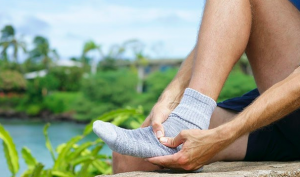 Cuboid syndrome describes the dislocation or subluxation of the cuboid bone, meaning it has moved out of place and alignment relative to the rest of the bones of the foot.
The cuboid bone is located on the outside of your foot, connecting at its front side with the fourth and fifth metatarsals (long bones of the foot) and at its back end, with the heel bone (calcaneus). It is held in place by ligaments and a joint capsule. Damage to these tissues can cause the cuboid to move out of place, resulting in painful symptoms on the outside of the ankle.
Cuboid syndrome describes the dislocation or subluxation of the cuboid bone, meaning it has moved out of place and alignment relative to the rest of the bones of the foot.
The cuboid bone is located on the outside of your foot, connecting at its front side with the fourth and fifth metatarsals (long bones of the foot) and at its back end, with the heel bone (calcaneus). It is held in place by ligaments and a joint capsule. Damage to these tissues can cause the cuboid to move out of place, resulting in painful symptoms on the outside of the ankle.
What causes cuboid syndrome?
The two primary causes of cuboid syndrome include injury and overuse. Pronation, or flat feet, has shown to be present in a majority of people that are affected by cuboid syndrome, with other risk factors including poor footwear, a history of previous injury, running on uneven surfaces and obesity.Injury
Injuries that cause the foot to twist inwards while pushing the cuboid out can dislocate the cuboid bone and cause cuboid syndrome. This often occurs in an inversion ankle sprain where the outside (lateral) ligaments can be overstretched and no longer hold the cuboid effectively in place. Other injuries can include falls and misstepping.Overuse
Overuse injury to the cuboid typically occurs through the abnormal strain of the peroneus longus muscle, which runs down the outside of the leg and down around the outside of the ankle. Repetitive strain on the peroneus longus through activities such as running and ballet can pull on the cuboid and cause it to dislocate over time.What are the symptoms?
The main symptom of cuboid syndrome is pain on the outside of the foot, which may be exacerbated by weight-bearing. Other symptoms may include:- Redness and swelling in the region of the cuboid
- Pain that may radiate to the toe
- A feeling of weakness on the outside of the foot
- Limping or difficulty walking
How is cuboid syndrome treated?
Initially, the PRICE principles (protection, rest, ice, compression and elevation) can help to reduce swelling and painful symptoms. The cuboid will then need to be manipulated back into place. Following this, treatment focuses on facilitating the healing and repair of the tissues around the cuboid, as well as reducing the risk of future re-injury. This may include:- Using orthotics to support the cuboid and correct any biomechanical issues at the feet
- Footwear assessment to ensure your shoes are helping and not hindering your recovery
- Stretching and strengthening tissues to restore strength the range of motion to the affected joints in your foot
- Activity modification to prevent further damage while your injury heals
- Addressing any other contributing factors to the cuboid injury, such as ankle instability








